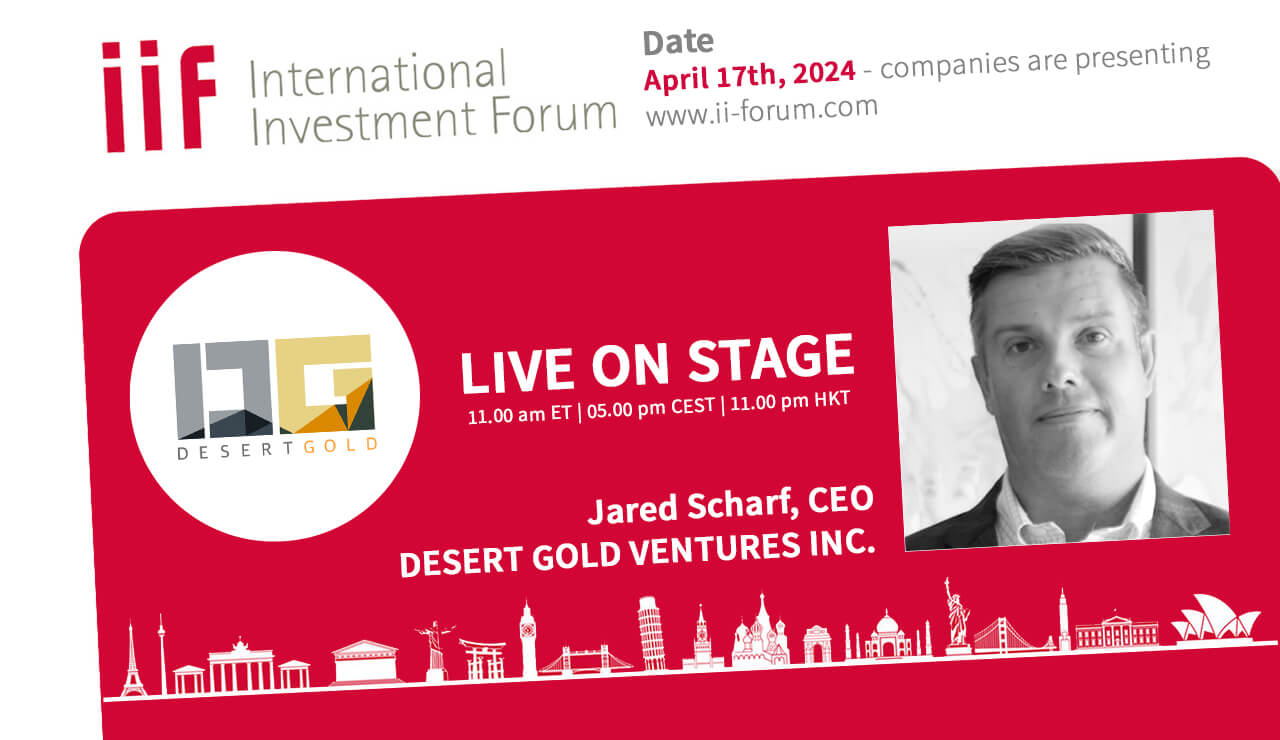April 5th, 2024 | 07:30 CEST
Desert Gold Ventures, Barrick, Intel - Stagflation in the US as a gold price turbo?
Gold has reached another record level of over USD 2,300 per ounce. Investors are betting that the US Federal Reserve will cut interest rates later this year. Gold has been on an upward trend since mid-February. On the one hand, it has a reputation for maintaining or increasing its value during periods of inflation. On the other hand, it is seen as a store of value should FIAT money be significantly devalued - after all, gold has been considered a currency for millennia. For Desert Gold Ventures, the timing is right to complete its exploration drilling program in Africa. Demand for the precious metal is unabated. These are good times for gold explorers and producers. Barrick CEO Mark Bristow suspects stagflation in the US, which will further drive up the price of gold. Declining economy and rising inflation? It is not a suitable environment for US companies. One company seemingly lagging behind is Intel. The Company issued a profit warning this week. We take a look at what this means for investors.
time to read: 5 minutes
|
Author:
Juliane Zielonka
ISIN:
DESERT GOLD VENTURES | CA25039N4084 , BARRICK GOLD CORP. | CA0679011084 , INTEL CORP. DL-_001 | US4581401001
Table of contents:

"[...] We have already discovered 1.1 million ounces of gold on our 440 km2 flagship SMSZ Project and our stock market value is currently around USD 10.60 per troy ounce in the ground. [...]" Jared Scharf, CEO, Desert Gold Ventures Inc.
Author
Juliane Zielonka
Born in Bielefeld, she studied German, English and psychology. The emergence of the Internet in the early '90s led her from university to training in graphic design and marketing communications. After years of agency work in corporate branding, she switched to publishing and learned her editorial craft at Hubert Burda Media.
Tag cloud
Shares cloud
Desert Gold Ventures: Exploration core drilling in Africa completed: New findings on gold deposits in Mali
The massive purchases by central banks, especially in China, contribute to the rise in the price of gold. Chinese investors are increasingly turning to the precious metal. In the last 16 months alone, the Chinese central bank has added considerable quantities of gold to its reserves. Gold is more sought-after than ever before.
For Desert Gold Ventures, it is precisely the right time to ensure a supply of the coveted precious metal. Four exploration core holes have now been successfully completed. Drilling totaled 729 m, including two holes at Mogoyafara South and two at the Frikidi Zone.
*CEO Jared Scharf commented: "Thanks to the support of our shareholders, we were able to utilize the core drill that was on site for our Preliminary Economic Assessment (PEA) to drill four additional high-priority exploration core holes.* These holes were designed to answer specific geological questions. The findings from the core are very encouraging, and we look forward to the assay results".
Mogoyafara South hosts estimated mineral resources of 412,800 ounces of gold with a grade of 1.05 g/t Au, constrained by an open pit. This deposit represents the largest known gold deposit to date at the SMSZ project and is open along strike and at depth. Two core holes have been completed in one area.
61 rock samples were collected from the Frikidi gold target, of which five samples returned 100 g/t Au or higher. Frikidi represents an area of numerous artisanal mine workings within a 5 km by 2.5 km area. Core intervals with quartz-veined portions, intersected from 23.9 m to 39.0 m, are consistent with gold-bearing rock grab samples collected on surface.
Assay results are pending, including validation of a historical drill intercept of 1.07 g/t Au over 26 m, which may represent a new trend of mineralization. Step by step, Desert Gold Ventures is approaching the gold deposits in their area. Investors can be part of the journey from the beginning. CEO Jared Scharf will present live at the 11th International Investment Forum (IIF) on April 17, 2024, and will be available for Q&A with investors. Click here for registration.

Barrick's Gold Price Forecast: How Global Economic Trends Affect the Market
Global economic challenges and the state of the US economy can create a long-term dynamic for the gold price. If the inflation rate continues to rise, this will lead to upward pressure on gold. This is good news for one of the largest gold and copper producers like Barrick. In a Bloomberg TV interview, CEO Mark Bristow comments as follows: "*I have been talking for some time about how everyone is hoping that (FED) interest rates will come down quickly and that will bring back interest in gold. *But I think there is a much deeper problem, which is that the global economy is not in good shape, and neither is the US economy. So, I think we will see higher interest rates for an extended period of time and the risk of stagflation. Ultimately, that will put upward pressure on gold again because then there is a risk to the global economy and, of course, to the US economy." Stagflation describes the rise in prices for goods and services while economic growth stagnates or declines.
Barrick's balance sheet, which was recently burdened by high levels of debt, is now one of the most robust in the industry. Thanks to strong operating cash flows, the Company has the ability to finance both existing and new organic growth projects. Barrick is also expanding its copper assets.
The Reko Diq gold-copper mine in Pakistan is one of the largest undeveloped copper-gold projects in the world and is 50% owned by Barrick. The project's re-establishment was completed in December 2022, and the first production is planned for 2028.
According to MarketBeat, Barrick has received an average "Moderate Buy" rating from nine rating agencies. Two analysts recommend "Holding" the stock, while seven recommend "buying" it. The average price target for the next 12 months among analysts who have updated their coverage of the stock in the last year is CAD 28.81.
Intel shares plummet - What the price drop means for investors
**Those working in an industry potentially affected by stagflation and facing rapid competition from rivals are at a disadvantage, especially if action is taken too late. This seems to be the case with computer giant Intel, which announced a profit warning this week.
According to Intel, the foundry business recorded a loss of USD 7 billion in 2023, with total revenue of USD 18.9 billion. This is the first time Intel has announced the revenue of its foundry business separately. Intel currently outsources about 30% of its chip processing to TSMC in Taiwan. Intel is thus strongly influenced by geopolitical factors.
In processors and servers, Intel has lost its place to AMD and Nvidia. In manufacturing technology, it has been overtaken by companies such as Samsung and TSMC. The consequence has been declining revenues and falling profits for around two years.
After this week's trading session, Intel announced that its foundry business is not expected to turn an operating profit until 2030. That is six years from now. The Company also anticipates becoming the second-largest semiconductor foundry in the world by that time. For investors, the share price plunge means one thing above all: taking a very close look at the supply chains and answering the question: who will emerge as the number one player in the semiconductor foundry industry during this period? According to Visual Capitalist, it is TSMC, which is currently struggling with earthquakes in its own country. Intel is heavily dependent on its Taiwanese supplier. The tensions between East and West make ongoing business a balancing act. While the US government aims to support Intel with subsidies to manufacture chips domestically, Intel hesitates to embrace the idea.
The threat of stagflation in the USA and rising inflation are increasingly causing investors to turn to inflation-protected assets. This could mean that the price of gold will continue to rise. Gold explorers and producers such as Desert Gold Ventures and Barrick offer investors an intelligent form of investment to profit from the boom in demand. Desert Gold Ventures has successfully completed its four exploration wells in Africa and is now having the rock samples analyzed. Barrick is expanding its portfolio and is increasingly focusing on copper, with a mining project in Pakistan. Intel, on the other hand, is in the midst of a crisis and has issued a profit warning for its foundry business. The grand senior of the semiconductor industry has lost touch with Nvidia and AMD. Its heavy dependence on TSMC for foundry production is now taking its toll, as setting up a production factory in its own country would be too cost-intensive despite government subsidies. Investors should, therefore, carefully consider how they reallocate their portfolios and invest in inflation-resistant companies or assets located outside the USA.
Conflict of interest
Pursuant to §85 of the German Securities Trading Act (WpHG), we point out that Apaton Finance GmbH as well as partners, authors or employees of Apaton Finance GmbH (hereinafter referred to as "Relevant Persons") may hold shares or other financial instruments of the aforementioned companies in the future or may bet on rising or falling prices and thus a conflict of interest may arise in the future. The Relevant Persons reserve the right to buy or sell shares or other financial instruments of the Company at any time (hereinafter each a "Transaction"). Transactions may, under certain circumstances, influence the respective price of the shares or other financial instruments of the Company.
In addition, Apaton Finance GmbH is active in the context of the preparation and publication of the reporting in paid contractual relationships.
For this reason, there is a concrete conflict of interest.
The above information on existing conflicts of interest applies to all types and forms of publication used by Apaton Finance GmbH for publications on companies.
Risk notice
Apaton Finance GmbH offers editors, agencies and companies the opportunity to publish commentaries, interviews, summaries, news and the like on news.financial. These contents are exclusively for the information of the readers and do not represent any call to action or recommendations, neither explicitly nor implicitly they are to be understood as an assurance of possible price developments. The contents do not replace individual expert investment advice and do not constitute an offer to sell the discussed share(s) or other financial instruments, nor an invitation to buy or sell such.
The content is expressly not a financial analysis, but a journalistic or advertising text. Readers or users who make investment decisions or carry out transactions on the basis of the information provided here do so entirely at their own risk. No contractual relationship is established between Apaton Finance GmbH and its readers or the users of its offers, as our information only refers to the company and not to the investment decision of the reader or user.
The acquisition of financial instruments involves high risks, which can lead to the total loss of the invested capital. The information published by Apaton Finance GmbH and its authors is based on careful research. Nevertheless, no liability is assumed for financial losses or a content-related guarantee for the topicality, correctness, appropriateness and completeness of the content provided here. Please also note our Terms of use.




